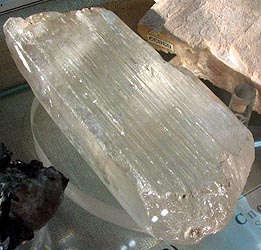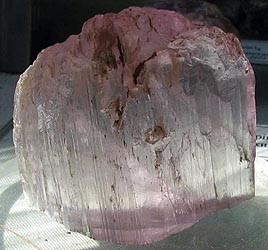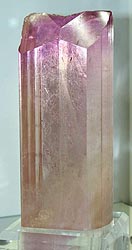KUNTSIT, GEDDENIT, SPODUMEN
 Spodumene is a lithium-containing pyroxene crystallizing in a monoclinic syngony, a prismatic class of symmetry. It is the main lithium ore. The name is associated with the most characteristic for this mineral grayish-white color. In 1879 in North Carolina (USA) was discovered spodumene emerald green color, called giddenitom. Pink spodumen from pcs. California (USA) - kunzite - was first described in 1902. Transparent colorless, yellow, yellowish-green specimens of ordinary spodumene (trifan) can also be used as jewelry stones. The emerald- and bluish-green color of giddenite is associated with the presence of vanadium or chromium ions which replace isomorphically aluminum ions in the spodumene structure, and pink, violet-pink color of kunzite-manganese ions. Upon irradiation, the pink color of the kunzite becomes green. Many spodumens, especially lightly colored, discolour under the influence of sunlight.
Spodumene is a lithium-containing pyroxene crystallizing in a monoclinic syngony, a prismatic class of symmetry. It is the main lithium ore. The name is associated with the most characteristic for this mineral grayish-white color. In 1879 in North Carolina (USA) was discovered spodumene emerald green color, called giddenitom. Pink spodumen from pcs. California (USA) - kunzite - was first described in 1902. Transparent colorless, yellow, yellowish-green specimens of ordinary spodumene (trifan) can also be used as jewelry stones. The emerald- and bluish-green color of giddenite is associated with the presence of vanadium or chromium ions which replace isomorphically aluminum ions in the spodumene structure, and pink, violet-pink color of kunzite-manganese ions. Upon irradiation, the pink color of the kunzite becomes green. Many spodumens, especially lightly colored, discolour under the influence of sunlight.
All spodumens have pronounced pleochroism: the color of the kunzite according to Np is dark purple or dark pink, Nm purple or pink, Ng kunzite is colorless; The color of the hiddenite is Np emerald green, according to Nm bluish-green, the Ng mineral is colorless. This property spodumenov must be taken into account when cutting them. In order to get the brightest beautiful coloring, the area when cutting the stone is located almost at right angles to the edge of the prism. Glitter is glass, on the planes of cleavage - pearly ebb. The hardness is 6.5-7. The density is 3.0-3.2 g / cm3. Kunzite luminesces in the ultraviolet rays in yellow or orange.
Spodumene occurs in the form of crystals, sometimes huge. The largest spodumene crystal with a mass of 65 tons, a length of 12.6 m and a cross-section of 13x2x1 m was found in the United States in pcs. South Dakota. Kunzite and giddenite are rare. The largest crystal of cunite from pcs. California with a mass of 2200 g is located in Harvard. Among the unique are the Brazilian cunzites stored at the Smithsonian Institution in the United States (880 carats) and the Mineralogical Museum of the Russian Academy of Sciences. The largest kunzite deposits are located in the USA (California, Pala region), Brazil (Minas Gerais), Madagascar. A unique deposit of kunzite is discovered in Afghanistan. The size of crystals of jewelry quality from 1x1x2 to 4x20x45 cm. Color of pink and red violet kunzite; There are blue, yellow-green, yellow, colorless transparent spodumene crystals.
The processed cunzites in diagnostics can easily be mistaken for sparrows, pink topaz, tourmaline, ruby, spinel and amethyst, from which it differs in refractive index, high birefringence (due to which it is possible to observe a sharp bifurcation of the ribs of the lower faces when viewing the stone through the pad), perfect cleavage, Strong pleochroism and yellow or orange luminescence.
Gyddenite is known in the pcs. North Carolina USA (Stony Point), where it was mined since 1879 together with a yellow-green, yellow and colorless spodumene. The mass of treated giddenites from this deposit, as a rule, did not exceed 2 carats. The largest giddenite measuring 3 x 0.6 cm is exhibited in Vienna. Extremely rare giddenite should not be taken for emerald and chrysoberyl.




Poisonous and radioactive dangerous stones and minerals
** - poisonous stones and minerals (mandatory check in the chemical laboratory + explicit indication of toxicity).
** - radioactive stones and minerals (mandatory check on the standard dosimeter + ban on open sales in the case of radioactivity over 24 milli / g / h + additional measures of population protection).
All rare stones are subject to mandatory inspection at the standard dosimeter for the permissible level of radiation and in the chemical laboratory for the absence of poisonous and evaporating components that are dangerous to humans and the environment.


Comments
Commenting on, remember that the content and tone of your message can hurt the feelings of real people, show respect and tolerance to your interlocutors even if you do not share their opinion, your behavior in the conditions of freedom of expression and anonymity provided by the Internet, changes Not only virtual, but also the real world. All comments are hidden from the index, spam is controlled.